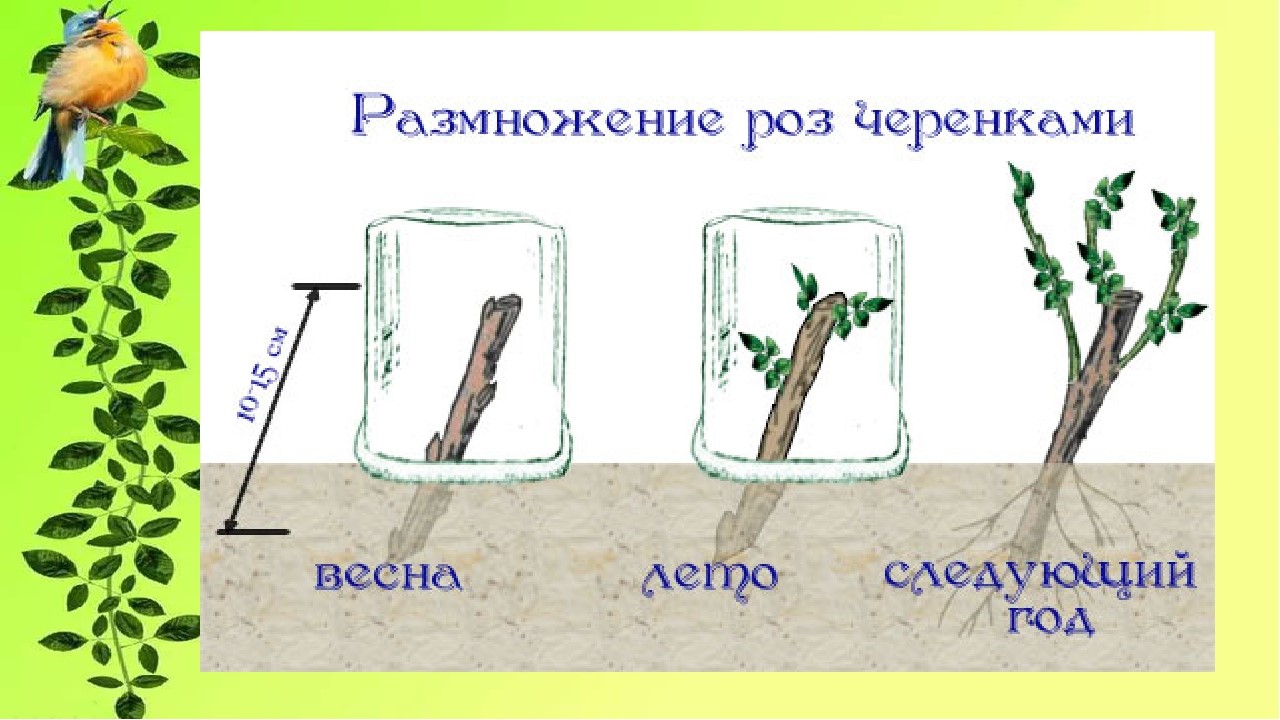Content
Roses can be propagated in several ways. One of the most common is cuttings. To perform the procedure correctly, you must adhere to the timing and order of work. Knowing the basic rules, it will not be difficult to root a rose cutting in the spring.
Pros and cons of spring cuttings

Stages of development of rose cuttings when planting in spring
This method has both good and bad sides. The advantages include:
- The culture does not grow and does not turn into rose hips, making care less demanding.
- Most types of roses can be propagated.
- The qualities of the mother plant can be transmitted with high accuracy.
- You can get a large number of roses from one parent.
- Low chance of growing underdeveloped specimens.
In addition, cuttings can be transported over long distances. In the spring, they are stuck into potatoes and wrapped in a layer of paper and perforated polyethylene. If you follow this technique, spring storage at t = 3 °C can be extended to one month.
There are only two disadvantages to cuttings:
- Problems with the reproduction of specific species. For example, it will be very difficult to plant park or yellow roses.
- It is impossible to determine exactly what features will be transmitted to the plant in the case of hybrid roses.
Difficulties with planting also arise with the arrival of cold weather. Due to insufficient frost resistance, propagation of roses by cuttings in the spring is difficult. Many varieties are capable of restoring frostbitten areas, which cannot be said about hybrid varieties.
When to plant roses from cuttings in spring
In order for roses to grow quickly, the plant should be propagated in late spring or summer. Select slightly hardened shoots. The plant should not begin to bloom, otherwise the processes of shoot development will decrease. The timing depends on the variety. There are long-growing crops that do not want to take root quickly. It is better to cut roses in early spring or winter so that they have time to grow by autumn.
Preparation of cuttings
To propagate roses in the spring, you need to prepare cuttings. Only healthy areas are cut, without signs of damage by fungi or pests. From the middle of the shoot, using a clean knife, cut cuttings (from 6 to 14 cm) with 3-4 formed buds. The cut angle of the upper part is made even, the lower part is made at 45°. Leave 1-2 leaves on top (if they are large, cut them off), and remove them completely from below. This is done in order to reduce the evaporation rate.

Experts also recommend treating rose cuttings with Radifarm before planting in the spring.
In the spring, for normal growth, the bushes are sprayed with “Epin” or “Kornevin”; it is permissible to use “folk remedies” - aloe or honey. The stem is placed in water (no more than 4 cm) for half a day.
How to propagate roses by cuttings in spring
Rose cuttings can be rooted using several methods. The most common were:
- in pots;
- in water;
- in potatoes;
- in the package;
- burrito method;
- Trannoy's method.
Each method has its own distinctive features that are worth considering separately.
In pots
If seedlings are often transported, then choose individual pots (with only one plant). The cuttings are processed and dried. Drainage is formed at the bottom of the container; small stones or bricks are suitable for this. The pot is filled with garden soil or a specially prepared substrate. It is better to purchase special soil from a flower shop.
The shoots are deepened into the ground, leaving one or two buds on the surface, and covered with a bottle or film. You need to keep the soil moist. As soon as the first leaves appear on the cuttings, the bottle can be removed.
In water
Cuttings are also grown in water. To do this, you need to boil it, add a little coal and a few drops of growth stimulator. Leaves should not touch water, as if there is too much moisture they may begin to rot. The surface is covered with a film with holes for the stems.
The water is changed 2-3 times a week until callus forms on the sprout. The process takes no more than 22 days. After the roots have formed, they are planted in loose soil. The liquid is not changed completely; they mainly add what has already evaporated.

Keeping cuttings in water is one of the most effective ways to propagate roses.
This is a fairly simple method of cutting roses in the spring, but it has one drawback.Due to insufficient air, underwater roots become more fragile. If you look closely, they are slightly thinner than ground ones. The transplant must be done carefully.
In potatoes
To plant rose cuttings in the spring, you can use potatoes. To do this, select medium or large tubers, cut off the sprouts from them and make a hole in the middle. Its depth should coincide with the diameter of the shoot cross-section. Take a container, form a drainage, cover it with fine-grained sand (at least 9 cm) and insert the cutting into the potato.
In this case, good lighting is necessary. The shoots are buried to the depth of one bud and each sprout (if there are several of them in the potato) is covered with a bottle. It is removed every day for ventilation for 10 minutes. Watering is carried out with plain water. Sugar is added to it once a week. After 15-20 days, roses can be planted in a permanent place.
In the package
For propagation you will need moss and aloe. You can find them at a flower shop. Aloe is mixed with water in a ratio of 1:9 and the moss is soaked in the resulting solution. The latter is placed in the lower part of the future plant and wrapped. The cutting is covered with a plastic bag, filled with oxygen and closed. The sun's rays should not fall on it; a place should be chosen that is moderately illuminated. On average, roots are formed already in the third week. After this, you can move the rose into the pot.
Burrito method
If none of the methods work, you can consider this one. It must be borne in mind that the sprout does not always produce roots.The cuttings are placed in a container with a growth stimulator (instructions on the product packaging) and wrapped in newspaper soaked in water. The plant is placed in a dark place. Constantly maintain humidity.

Propagating roses using the burrito method can be effective if other methods fail
Trannoy method
Used to propagate a large number of plants. From the rooted sprouts, you can choose the strongest ones. To do this, you will need to cut the branches (20 cm each), remove the leaves and place them in a pot with special soil for roses. After this, the cuttings are well watered and covered with film.
Planting rooted rose cuttings in the ground in spring
Before planting, you should take into account the type of root system (closed or open) and the warming of the area. It is better to plant roses from cuttings in late spring, when the snow has melted and the soil has dried.
The cuttings must be monitored for a month so that if something happens, you can help them. Residents of southern regions are allowed to undergo transplantation earlier.
Depending on the variety, planting conditions may vary. Light-loving roses prefer open spaces, while shade-loving roses get along well under the crowns of trees, near fences and bushes.
Within two months, the soil is carefully dug up to a depth of half a meter, compost, clay and sand are added (proportion 2:1:1) and mixed. Before planting, the soil is updated with fertilizers. Loamy soil requires virtually no treatment, while clayey soil requires the use of slaked lime to reduce the acidity coefficient.
Aftercare

Young cuttings need regular watering and fertilization more than ever.
For stable growth, roses need care. In the early stages, the plant requires insulation. It could be as follows:
- Sprinkling. The soil is watered every 30 minutes with warm water to prevent the stem from freezing.
- Smoke. The plant is enveloped in smoldering material from three layers - firewood, straw and earth. Holes are made in the resulting structure to allow smoke to escape. The straw is set on fire immediately with the arrival of cold weather.
- Shelter. The simplest and most common method of insulation. This involves keeping the rose in a plastic or glass shelter at constant temperatures. Usually plastic bottles are used. If the material is opaque, cover it only at night.
Rooting roses from cuttings in the spring is the fastest. Even an inexperienced gardener can cope with the procedure. The main thing is to follow simple instructions, do not forget to care for the plant and monitor the air temperature.
Conclusion
There are several ways to root a rose cutting in the spring. The choice of technique depends on the conditions and preferences of the owner. Cuttings can also be carried out in the fall, but in this case it is necessary that the effect of cold be minimized.








